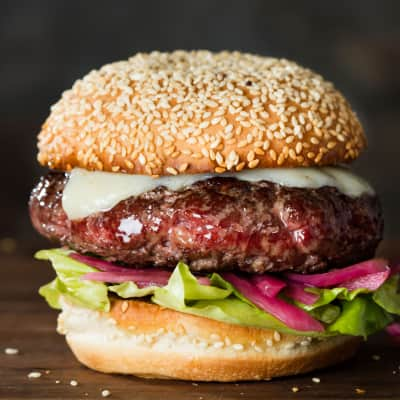Ground meat is a staple in many homes. We use it to make burgers, pasta sauce, meatballs, and meatloaves. We often buy it straight from the supermarket. But it's also possible to grind it at home with an ordinary food processor. And for the ulimate burgers—like our Juicy Pub-Style Burgers—we find that's the best option. Grinding at home not only allows us to control the type of cut, but how coarsely it's ground. We decided to take a look at how the size of the grind impacts the texture of a burger.
Why Home-Ground Meat Makes More Tender Burgers
Published May 29, 2019.

Experiment
We made three sets of burger patties, one with store-bought 90 percent lean ground chuck and two with flap meat that we ground ourselves in the food processor (we ground one batch to mimic the texture of the store-bought meat; the other we ground moderately coarse in the manner we prefer—see “Getting the Perfect Grind,” below). After cooking all three sets of burgers to medium-rare, we let them rest for five minutes and then dropped a large Dutch oven on each patty from 6 inches above the counter. We repeated the test three times.
Results
Messy—but in a good way. The burgers reacted very differently to the weight of the Dutch oven. The one made from the dense store-bought ground meat remained intact (though somewhat flattened) and did not ooze any liquid at all. The burger made from the beef we ground to mimic the store-bought texture spread a bit but did not release any of its juices. The looser, more coarsely home-ground burger, however, flattened like a pancake, spewing its moist interior all over the board.
Smashing Burgers: Home-Ground and Store-Bought

HOME-GROUND
The burger made from meat we ground to perfection at home was much more tender, and therefore splattered and smushed much more under the weight of the falling Dutch oven.

STORE-BOUGHT
The burger made from store-bought ground meat cooked up dense and tough and remained relatively solid when smashed with a heavy Dutch oven.
Takeaway
One important variable in ground beef is the texture of the grind. Because we could control the texture of the meat we ground ourselves, we were able to construct a looser, more tender burger with our coarse-ground meat. Because we could not control the size of the grind in the burger patty made from store-bought meat, it was much denser, tougher, and ultimately much more resilient when smashed. (In this case, resilience is not a good thing!)
A second variable in ground beef is the choice of cut. Because we could choose to grind flap meat, a cut with more fat and flavor than chuck, both of our home-ground burgers tasted richer and more flavorful (no matter how they smashed) than the store-bought.
Getting the Perfect Grind
Underprocessed meat will lead to gristly bits in the finished burgers and patties that don't hold together. Overprocessed meat becomes rubbery and dense as it cooks. Perfectly ground meat contains pieces that are fine enough to ensure tenderness but coarse enough that the patty will stay loose.




